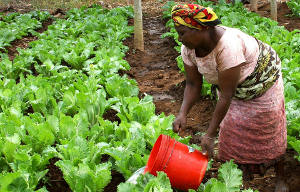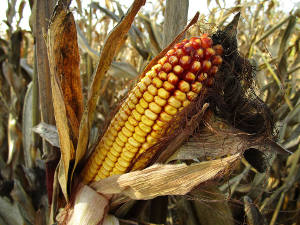Agricultural insurance in Africa
A report published in September 2015 on the sideline of the G20 showed that out of the 178 million farmers in developing countries, having underwritten index insurance in 2014, only 450 000 are African, that is, 0.25%. The vast majority of the individuals who subscribed to this kind of coverage is located in India and China. These figures are living proof that the African market of agricultural insurance is endowed with substantial margin of growth.
Agricultural insurance in West Africa
 |
The introduction of agricultural insurance is more recent in Sub-Sahara Africa than in the Maghreb.
In 2011, an insurance plan called Assurance Récolte Sahel (Sahel crop insurance), (ARS), was launched by the World Bank and several other local and international institutions(1). This project was designed to establish an index-based insurance for the coverage of drought risks. This scheme is now under experiment in four countries: Senegal (peanuts, corn), Mali (cotton, corn), Burkina Faso (cotton, corn) and Benin (corn).
Agricultural insurance in Senegal
In 2015, agriculture absorbed 50% of the Senegalese labor force, contributing with 17.5% of GDP. Endowed with a total area of 196 000 Km 2 , Senegal dedicated 140 000 Km 2 to agriculture, 80 000 Km 2 of which are agricultural lands in the true sense of the word and 60 000 Km 2 designed for breeding.
The main obstacles to Senegalese agriculture are drought in the Sahel region, poor soil fertility, pest attacks (locusts and other harmful pests) and the poor revenues yielded by agricultural holdings. In an attempt to help farmers, the Senegalese State set up in the beginning of 2000s two funds attached to the Caisse Nationale du Crédit Agricole du Sénégal CNCAS (Senegal’s national fund of agricultural loans). The first was tasked with the coverage of climate-related risks while the task of the second was to provide collateral for 75% of repayment defaults for agricultural loans.
In 2008, the Compagnie Nationale d’Assurance Agricole du Sénégal (Senegal’s national agricultural insurance company) in which the State detains a 36% shareholding was set up. The remainder of the capital is spread out among local insurance companies and farmers’ associations. The State subsidizes 50% of the written premiums.
A tax relief program on agricultural insurance plans and a decrease in the interest rates on loans are also part of the measures designed by the State to support the business.
In 2012, CNAAS launched its first index-based insurance products in association with the Sahel Crop Insurance (ARS) project, a drought plan for the crops of peanuts and corn. The cover may amount up to 10.5 million USD per department in the event of natural disasters. The Senegalese State intervenes when the cost of claims exceeds this amount.
Agricultural micro-insurance has drawn interest among farmers more than classical insurance whose cost is relatively high. In 2014, CNAAS reported 30 000 contracts of micro-insurance , versus only 3 000 for classical insurance.
The new experiences
Convinced about the importance of agricultural insurance and its bearing on economic development, several countries in West and Central Africa such as Gabon, Cameroon and Mauritania are now intent on developing this business.
Agricultural insurance in Gabon
Gabon features huge natural assets and a climate prone to agriculture. The oil discoveries have, nonetheless, slowed down the development of the sector which accounted for merely 4.7% of GDP in 2015, a rate that has gradually dwindled down in recent years.
With 90% of city dwellers, Gabon is considered as one of the most urbanized countries in Africa.
The country is suffering from food dependency, with imports of agricultural and food products accounting for 21% of the country’s total imports. Nearly 40% of the population is confronted with a food security issue. In order to face this situation, the Gabonese government set up in 2017 an agricultural development fund (FDA) in which it detains a 49% stake. The remaining 51% are held by agricultural inter-professional organizations. Endowed with a capital of 2 billion FCFA (3 million USD), the institution is aiming at providing loan guarantees for the benefit of farmers, covering them against natural and environmental hazards.
Agricultural insurance in Cameroon
In late 2016, representatives of the World Bank, African Development Bank (ADB), the International Finance Corporation (IFC), along with several other insurers and representatives of the Cameroonian government met in Douala. The introduction of an index-based agricultural insurance ranked high on the agenda of the meeting. This initiative is all the more important as 60% of the population operates in the agricultural sector. Agriculture actually accounted for 22.8% of GDP in 2015.
Agricultural insurance in Mauritania
Located in an overwhelmingly desert area with very few arable lands, Mauritania has been often regarded as a country solely confined to breeding. The development of an agricultural zone along the Senegal River has pushed the authorities to seek insurance solutions in order to preserve farmers’ revenues. Agricultural insurance may indeed stand as a first response to this problem.
In late October 2015, a Mauritanian delegation paid a visit to Morocco in order to study the local agricultural insurance system.
Agricultural insurance in East Africa
 |
The development of agricultural insurance in East Africa has proved to be all the more significant as drought has taken its toll on the area in an endemic fashion. According to the Food and Agriculture Organization of the United Nations (FAO), the Horn of Africa is likely to sustain serious food shortages due to droughts in the coming years. Over 17 million people living in Ethiopia, Eritrea, Djibouti, Somalia, Uganda, Kenya and South Sudan are under the threat of famine. For the governments and international relief organizations, agricultural insurance stands as a solution, among others, to overcome this threat.
In Ethiopia, the United Nations Organization launched in 2006, in association with the local government and French insurer AXA a drought-insurance scheme for the benefit of farmers. The initiative comes within the framework of the World Food Program (WFP).
In 2016, Ethiopia confirmed its intention to institute an agricultural insurance market. The government has therefore started talks with reinsurer Swiss Re to conduct in-depth surveys on the issue.
Another big project initiated by GIIF, (the Global Index Insurance Facility) in association with several local insurers such as UAP Insurance (Kenya), APA Insurance (Kenya), SORAS Insurance (Rwanda) and UAP Insurance Tanzania (Tanzania), has been recently set up in East Africa in the area of the Great Lakes.
In November 2016, the first agricultural insurance crop policy was marketed in Tanzania, a country where agriculture contributed with more than 30% to GDP in 2015. Called “Linda Mbegu”, in English “insure your crops”, this plan is designed to protect farmers against the consequences of rainfall shortage.
Agricultural insurance in southern Africa
Agricultural insurance in South Africa
The development of the mining and manufacture industries during the twentieth century has marginalized agricultural activity. The contribution of agriculture to GDP has gradually diminished going from about 20% in the 1930s down to 12% in the 1960s and further down to 2.4% in 2015. Convinced about the significance of the primary sector, the State is planning on creating one million new jobs by 2030.
Agriculture in South Africa is facing numerous social and climate challenges. Before the abolition of apartheid(1) , the white farmers used to control more than 80% of farmland. The average size of their agricultural holdings was of 1 300 hectares. Black farmers, however, were in possession of small self-sufficiency lands not exceeding in average five hectares. In 1994, after the abolition of apartheid, an agricultural reform has been undertaken in the country, thus facilitating access to property for black populations.
With regard to weather, South African agriculture has undergone episodes of cyclic droughts. With the exception of the fertile zones located in the Cape region and along the shore, the bulk of the country is semi-desert.
South Africa experience in agricultural insurance
In 1970, South African authorities launched a subsidized insurance program designed to help farmers be covered against drought. Unfortunately, this initiative did not yield the expected results, with farmers deserting this program and settling only with the assistance provided by the ministry of agriculture to help them recover some of their losses. In 1996, a new system of agricultural insurance was introduced. Integrated within a strategic plan aimed at boosting agriculture, the project which was based on a public-private partnership was designed to protect farmers against climate hazards(2).
(1) End of the apartheid : 30 June 1991(2) www.agrisa.co.za/wp-content/uploads/2014/01/DRAFT-PROGRESS-ON-AGRICUTURAL-INSURANCE.pdf
Agricultural insurance in Zimbabwe
In 2015, agriculture accounted for more than 13.4% of Zimbabwean GDP, with Tobacco production standing as the main agricultural activity. The country is regarded to be the biggest producer of tobacco in Africa and the 6th producer worldwide.
Just like its big southern neighbor, Zimbabwe conducted an agrarian reform in 2000. Most of the tobacco farms belonging to the white were then seized back by the government and redistributed to small farmers. Following this initiative, tobacco production had been severely disrupted and the crops dwindled down by 79% between 2000 and 2008.
Agricultural insurance, including that of hail, represented 1% of the global market in 2016 whereas in 2010, this percentage amounted to 3%.
In an effort to offset this decline, the authorities launched several initiatives aimed at reviving the insurance of agricultural risks.
On the sideline of the 3 rd conference of the African Association of Agricultural Economists (AAAE) an index-based insurance program against drought was presented in 2010. This project which is mainly designed for small farm holdings is still under study(1).
(1) http://www.fondation-farm.org/zoe/doc/micro_network-brochure_agriculture-def-low_fr.pdfEvolution of agricultural insurance turnover in Zimbabwe (2010-2015)
in thousands USD| 2010 | 2011 | 2012 | 2013 | 2014 | 2015 | 2016 | |
|---|---|---|---|---|---|---|---|
Agricultural premiums | 5 402 | 8 531 | 8 317 | 9 060 | 8 211 | 6 595 | 5 539 |
Market total premiums | 182 930 | 307 293 | 390 056 | 468 145 | 514 547 | 546 781 | 562 525 |
Market shares | 3% | 2.8% | 2.1% | 1.9% | 1.6% | 1.2% | 1% |
Share of agriculture in the African countries’ GDP in 2015
| Country | GDP’ share in % |
|---|---|
| West Africa | |
| Senegal | 17.5 |
| Cameroon | 22.8 |
| Cote d'Ivoire | 22.7 |
| Togo | 40.7 |
| Benin | 25.3 |
| Gabon | 4.7 |
| East Africa | |
| Kenya | 32.9 |
| Sudan | 39.3 |
| Ethiopia | 41 |
| Rwanda | 34.6 |
| Liberia | 35 |
| Tanzania | 31.1 |
| Southern Africa | |
| South Africa | 2.4 |
| Zimbabwe | 13.4 |
| Mauritius | 3.5 |
